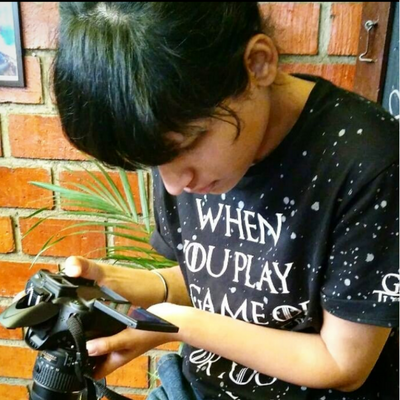Spangmik Village is a remote village situated 156 kilometers east of Leh, on the banks of famous Pangong Lake in Ladakh region. The village is located on a narrow stretch of land between the Chang Chenmo mountains and the Pangong lake. Spangmik village is very close to the Tibetan border and an army check post prevents any civilians from going any further towards the border.
Unlike some other regions in Ladakh that get cut off during winters, it remains accessible through the Chang La pass throughout the year. Since Spangmik is very close to the border, the Indian Army makes sure that this place is always accessible despite the difficult winter conditions. Visitors can, therefore, visit the Spangmik village both in summers and as well as in winters.
If you are visiting the Pangong Tso lake, I would strongly recommend you to spend a night at the Spangmik village. The camps near the lakes and the homestays at the village are a popular choice among travellers.

This is the mighty Pangong Tso. If you want to experience the magic of its changing colours, you must certainly spend a night here. Spangmik is the best place for a stopover. It’s rather unfortunate that not a lot of people know of this beautiful village.
Spangmik Village: An Overview
Before discussing travelling to Spangmik village, it is essential to understand the destination a little better. This overview will give you a brief idea about the place.
| Location
Around 7 km from the Pangong Lake |
| Accessibility
Throughout the year |
| Best Time to Visit
Summers Winters |
| Accommodation Options
Hotels, Camps and Homestays |
| Temperature
Summers: -5°C to 30°C Winters: -20°C to 10°C |
| Mobile Connectivity
Only Postpaid BSNL sims work here |
| Things to Carry
Summers – Woolens Winters – Heavy woollens and jackets |
| Ideal stay time
2 days |
How to Reach Spangmik Village?
Spangmik Village is situated at a distance of about 154 kilometres from Leh. It takes 4-5 hours to reach the village and Pangong Lake from Leh. The entire journey from Leh to Pangong Tso is splendid. It will be a good option to stay overnight at Spangmik Village and witness the beauty of Pangong Lake.
There are 2 routes to reach the Spangmik Village. It needs to be mentioned here that each year, both routes are constructed all over again for safe travel by the Border Road Organization (BRO). This is because, once the snow starts to melt and Shyok River is in its full strength, this road can’t be accessed.
Route OneLeh via Chang La or from Nubra Valley via Shyok Villages and Tangste. |
Route TwoLeh – Khardungla – Nubra Valley – Agham – Shyok Village – Durbuk – Tangtse- Pangong Tso – Chang Las |
Note: Route no. 2 can be accessed only in the early season when snow from mountains haven’t started to melt and Shyok River is not in its best appearances. This whole stretch has various water crossing (some nasty ones), loose rocks, sharp stones, big rocks underwater crossings or standing water or sometimes even Shyok river itself on the road.
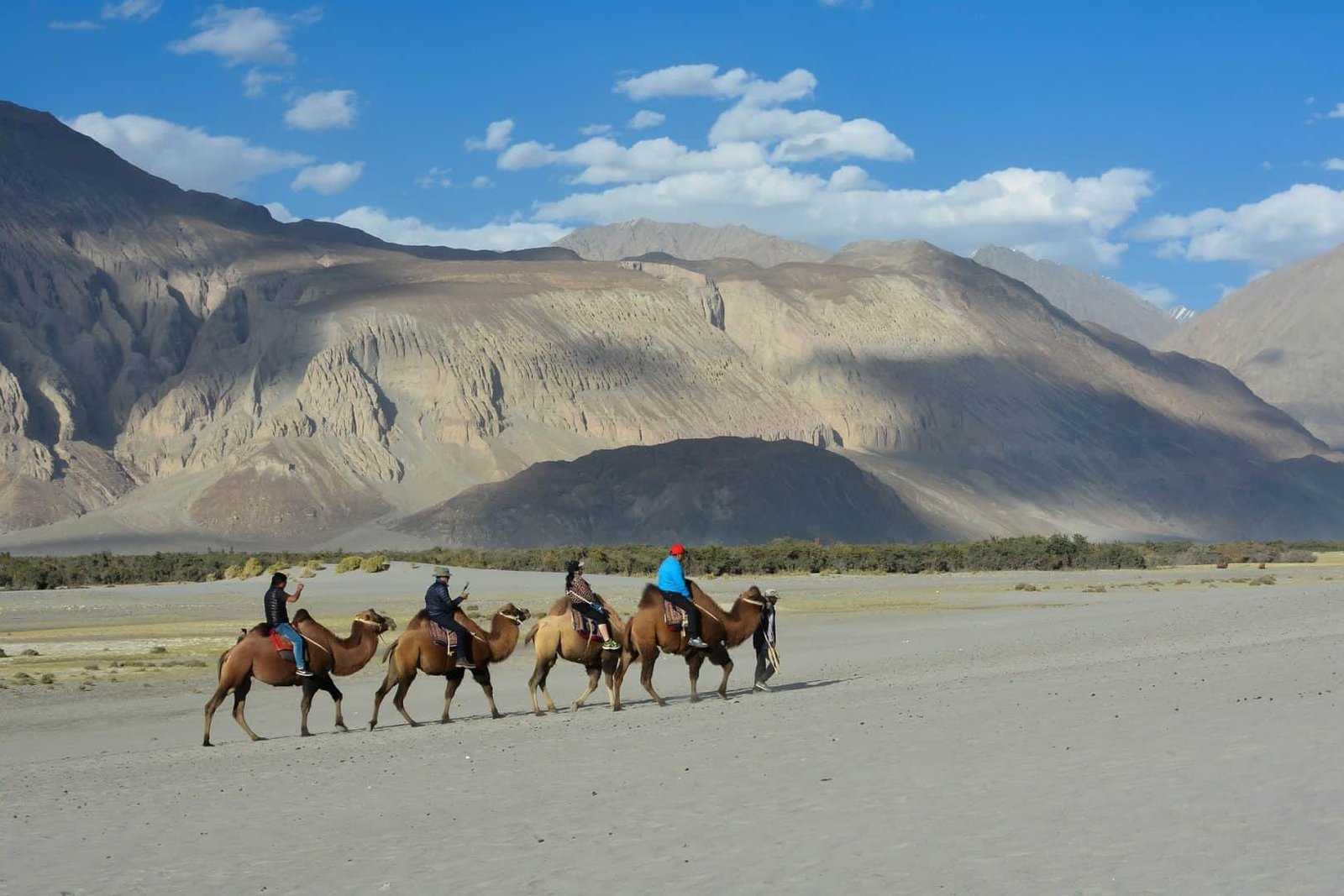
No matter what the route you choose, you’ll come across the beautiful Nubra Valley on the way. Do halt at this wonderful spot. In addition to being scenic, it has a rather interesting history – it used to be a trading route between Tibet and Turkistan!
However, it’s worth your time and has some of the best landscape sightings in the complete Leh journey. Previously, this route used to be challenging due to sharp stones and big boulders. This, however, is a thing of the past. It is now 85% road and 15% uneven terrain. Make sure your driver is familiar with this route.
Reaching Spangmik Village by Bus
There are not many public transportation options available when it comes to travelling within Leh. However, due to an influx of travellers, public transportation services have been improved off late. If you do not wish to shell out money on taxis, you can plan your visit to Pangong village and Spangmik village on a bus.
2 JKSRTC buses go from Leh to Spangmik Village every week. They start as early as 6.30 am on Saturday and Sunday and return the next day. You can plan your stay and visit to Spangmik village and Pangong Tso with the bus timings. The fare is a mere 250-300 INR (one way).
Make sure you confirm the bus timings a day before your visit.
Inner Line Permit for Visiting Spangmik Village and Pangong Lake
An Inner Line Permit (ILP) is a travel document issued by the Government of India. It allows visitors to travel to a protected area for a limited period of time. Obtaining the ILP is essential for all the citizens who do not belong to the state of Jammu and Kashmir. Foreigners travelling to Ladakh are required to obtain the Ladakh Protected Area Permit (PAP).
The PAP is required for visiting areas like Nubra Valley, Khardung La, Pangong Tso, Tso Moriri, Dah, Hanu Villages, Man, Merak, Nyoma, Loma Bend, Turtuk, Tyakshi, Chusul, Hanle, Digger La etc.
Spangmik Village: Know your hosts – The ‘Changpas’
Spangmik Village is home to a community people called ‘Changpas’. They are native to the Changthang valley of the Ladakh region. Only a handful of families reside in the village. This sparse population of the Spangmik village mainly depends on agriculture and goat rearing for income.
Much of the work happens during the short summer season when they cultivate crops like Barley and peas, take their pashmina goats out for grazing, and collect necessities for the long winter ahead. The pashmina goats are an important source of income for the people of Spangmik village. Wool from these goats are bought by traders mostly from North India. It is sent to Kashmir and Himachal where it’s woven into fine cashmere shawls. These shawls are then sold all over the world.
Summers are also the time when the travel season is at its peak. The residents are also busy looking after guests staying in Spangmik homestays and those visiting the Pangong Lake.

During winters, some of these people in Spangmik village move to warmer places. For others who stay, there isn’t much to do and they mostly stay indoors, attend to guests and take care of their goats. The way they live their lives is commendable.
Spangmik Village: What to Expect during Winters?
Winters, like in other parts of Ladakh are harsh in Spangmik Village. The temperatures can go down below minus 25°C during that time.
Off late, more and more adventurous travellers have started to visit Leh-Ladakh and Spangmik village and Pangong Tso during winters. Some families have turned their homes into ‘homestays’ for travellers.
Pangong Tso: The Main Attraction of Spangmik Village
No trip to Leh-Ladakh is complete without visiting the Pangong Lake, also known as “Pangong Tso.” It literally translates to “high grassland lake” and is situated at a height of about 14,270 ft. It is 134 kilometres long and extends from India to China. This saline water lake is 5 km wide at its broadest point.
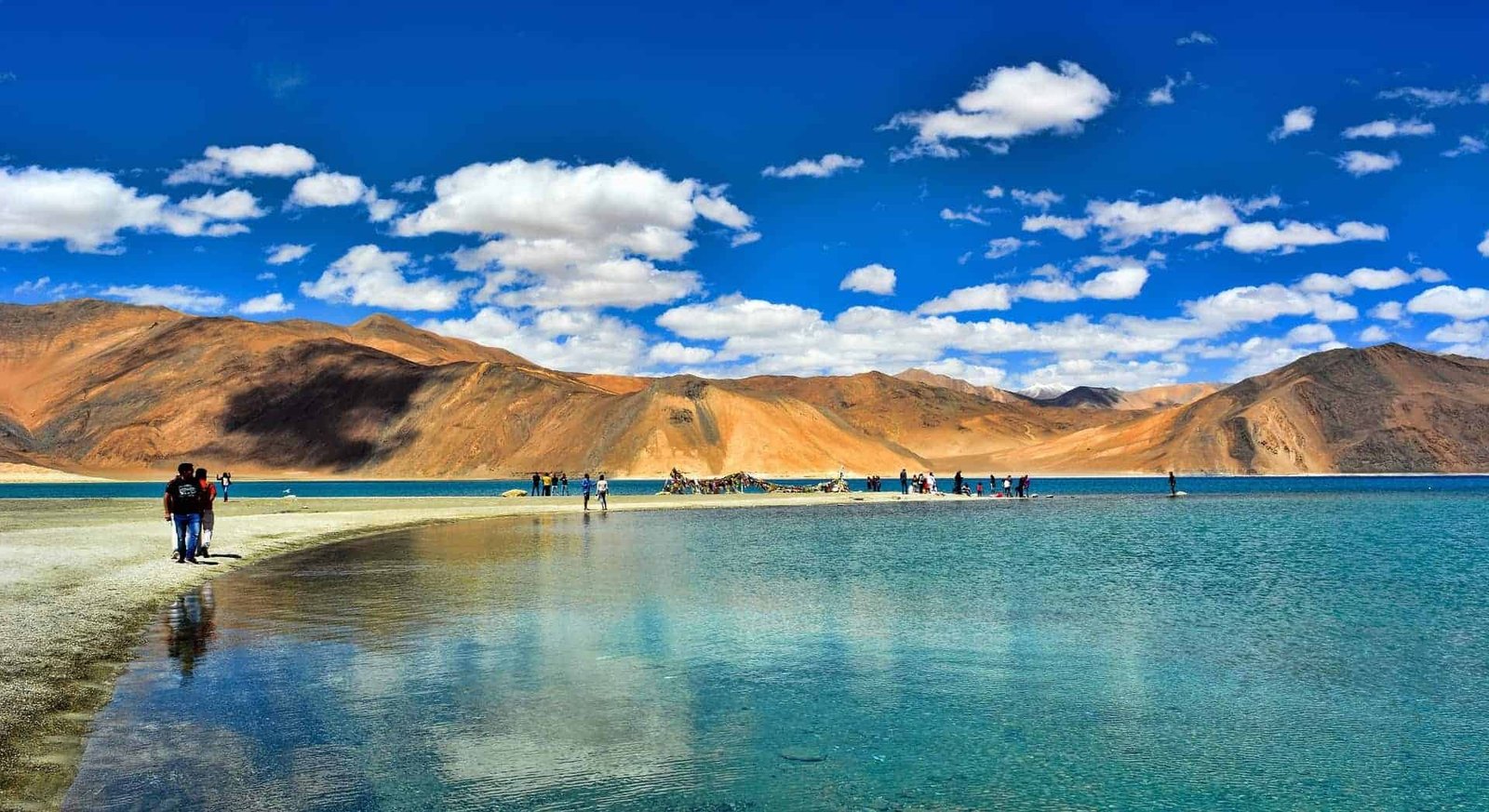
Standing at an elevation of more than 4,300 meters, Pangong Lake is the world’s highest saltwater lake. Here, you don’t need anything ‘to do.’ Simply staring at the unrealistic views and letting it all sink in is enough. It’s a must-visit in Ladakh.
Tip: An important thing to remember here is that the lake changes colours and therefore, you must plan at least one night’s stay at Spangmik village to witness the changing colours.
The Topography in Different Seasons
Broadly, the weather in Ladakh can be divided into summers and winters. While summers are cool and pleasant, winters are cold and harsh.
Summers: May-SeptemberSummers are considered the best time to visit Leh-Ladakh and Pangong Lake. The skies are clear and it is during this time, that you can see the lake change turn from one shade to another. Enjoy the cold breeze as you stroll around the lake. At night, if the skies are clear, you’ll get to witness the infinite spread of stars. Tip: Although it is officially summertime, do carry warm clothes as it will get chilly in the evenings and at night. |
Winters: October-MarchThe Pangong lake freezes completely or partially (depending on which month you are visiting) during the winters. The temperature can get even below -25°C. This is the best time to visit for the brave-hearted, who are ready to battle the extreme harsh temperature of Ladakh. Taking a walk on the frozen lake is a different feeling altogether. Sometimes, visitors can also be seen driving a car on the lake. Tip: Since the temperature is extremely low, wear layers of protective clothing. Also, carry some snacks as the food outlets near the lake are closed during winters. |
Other things to do in and near Spangmik Village
Apart from the obvious attraction, Pangong Lake, it might seem that there isn’t much to do here. However, spending some carefree time in itself is a rewarding experience.
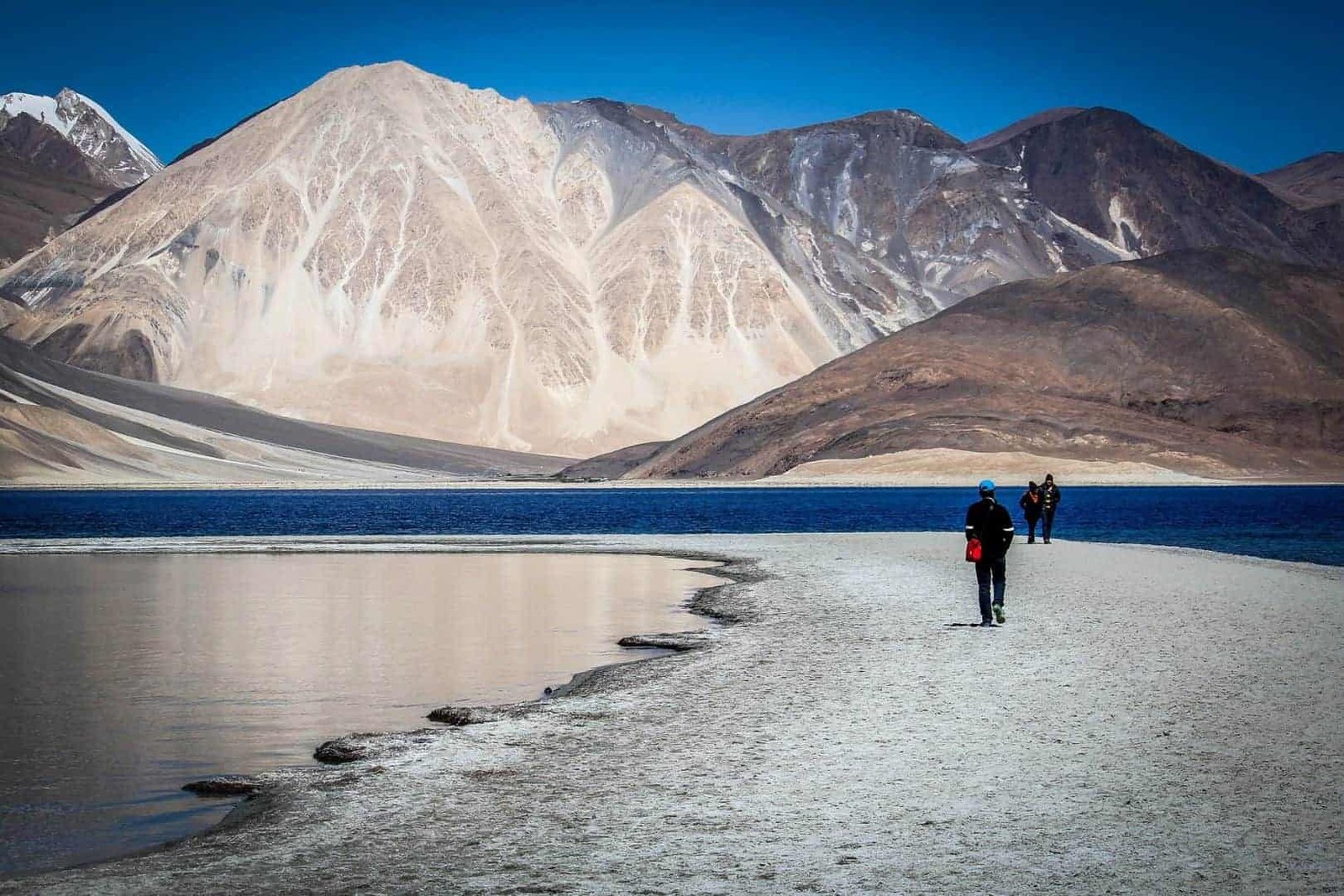
Who needs a list of activities to do in a place as serene as this? Spending some carefree time in itself is a rewarding experience. You can also explore the village, learn more about the locals and their way of life, or engage in some world-class photography.
| Since the population is too small, the Spangmik Village does not have a Monastery of its own unlike other places in Ladakh.
If you choose to stay here for more than a day, you can just wander around the place, chat with the locals and understand their way of life. The simple lifestyle of this remote village will leave you in awe of the seemingly unreal world. Spending some time in Spangmik village will make you forget all about the hustle-bustle of city life. Enjoy the beautiful views of the Chang-Chenmo mountains Range and snow-capped peaks of the Pangong Range from the Spangmik village. Several glaciers located on the northwest side of the Pangong Lake are also visible from the village. |
Accommodation Options in Spangmik Village
There are a few accommodation options to stay at Spangmik village. The options become limited if you are visiting during winters.
Homestays in Spangmik villageMany families in the Spangmik village have turned their homes into homestays. These cosy homes are the best when it comes to accommodation places at Spangmik village. The kitchen is generally also the living room where you can sip tea and catch up with fellow travellers and your hosts. This area is kept cosy with a fireplace cum cooking system, that also works as a centralized heating system for the room. Tip: If you have a choice, choose to stay in one of the Spangmik homestays. Although they lack any kind of luxury, they will give you a taste of local culture. By choosing to stay here you will also contribute to the local economy. Tip: If you are visiting during winters, these are the only places that will remain open. |
Spangmik HotelsThere are a few budget hotels and guesthouses near the Pangong Lake in Spangmik Village |
Spangmik TentsIn Spangmik village, one can also stay in tents on the banks of the lake Pangong. Most of the tents are clean, comfortable and warm. They also provide a spectacular view of the lake with the barren mountain backdrop. However, the tariff is much higher than all other accommodation available in the area. |
Food at Spangmik Village
There are a lot of food options available to travellers in Spangmik Village during the summertime. These are mostly concentrated near Pangong lake. You can enjoy Tibetan food like momos and thupka. Other than this, aloo paratha, dal chawal, bread omelette, Maggi noodles and soups are easily available.
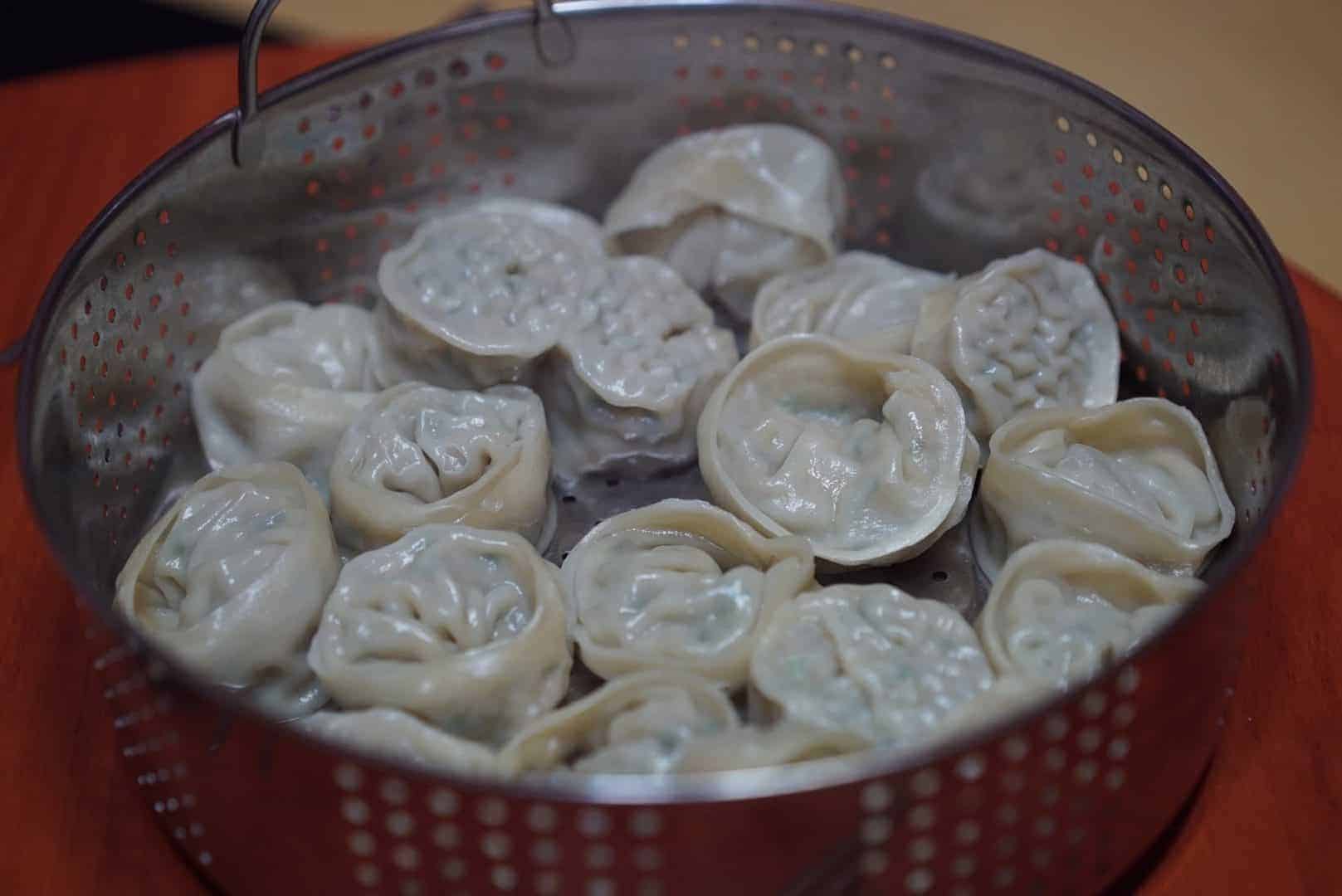
You will be sure to find freshly steamed momos in most parts of Ladakh. It’s an absolute treat to devour a plate of hot momos in the freezing cold. What’s even better is the spicy chutney it comes with. It makes for my favourite snack in the Himalayas.
However, during winters, most of these eating joints remain closed. This is when you can savour the simple home-cooked Ladakhi food served at your homestays.
Spangmik Village is a must-visit place on your Leh-Ladakh Trip. Whether it is summers or winters this place offers you a splendid landscape. Spend some time here and appreciate the beauty and simple living.
Happy Wayfaring 🙂

